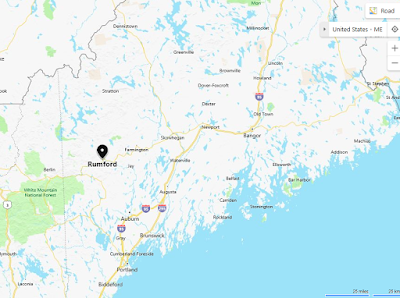Solomon Sutton Dane: 1820-1885
52 Ancestors Prompt “Nature”
Solomon Sutton Dane, my first cousin four times removed (he was my third-great-grandfather David Dane’s nephew), spent the majority of his life out of doors in nature—more the “nature red of tooth and claw” than the pretty, leafy nature we might imagine. Solomon worked as a merchant sailor for most of his life, spending brief periods onshore living with family, and during the 1860s, trying his hand as a gold miner in California, before heading back to sea.
Solomon was born around 1820 to parents John Dane and Sarah Sutton Dane. He was the second of their eventual eight children. The couple married in New Hampshire, but had relocated before 1817 to the town of Rumford, Maine, where John farmed. Rumford was founded in large part by settlers from the Concord, New Hampshire area, so that may help to explain why John and Sarah chose to move there.
I am not sure how Solomon came to decide on a career as a sailor, but it apparently was a common one for Rumford natives, despite the town’s location of over eighty miles from the port of Portland, with no other ports any closer. However, Rumford was situated on a river with a large waterfall, and was a popular fishing location, so Solomon was probably comfortable around water at a young age. If we look at the 1850 census record for Solomon, we find him at age 30 living with his parents and listing his occupation as “sailor”, I noted that the family just above his also includes a sailor son living with his parents, indicative that it was a popular alternative to farming.
One of the first records I have found for Solomon is a Citizenship Affidavit filed in Bath, England on October 10, 1839, stating that Solomon S. Dane of Rumford, Maine was filing for a Certificate of Protection. "Seamen Protection Papers," or "Seamen Protection Certificates," were issued to American seamen during the last part of the 18th century through the first half of the 20th century. These papers provided a description of the sailor and showed American citizenship. They were issued to American sailors to prevent them from being impressed on British men-of-war, during the period leading to and after the War of 1812. Solomon’s has a description written along the left-hand margin stating he was 5 feet 6 ½ inches tall with light brown hair, and that he was 19 years old.
I have little further information on his travels by sea. Obviously he crossed the Atlantic, having sailed to Bath, England. He eventually sailed the Pacific Ocean as well, landing on the coast of California, for by 1867 he appears on records in Sacramento California. Voter lists and the Great Register of California Voters from 1867 and 1868 show him living in Sacramento and list his occupation as “miner”. Although this is nearly twenty years past California’s 1849 Gold Rush, people were still making their way to the hills around Sacramento hoping to strike it rich. Solomon seems to have been one of those dreamers.
By 1869, he was working as a laborer, and boarding at the Haines Exchange on the corner of J and 11th Streets in Sacramento The site is now near the heart of downtown Sacramento, and is the location of the Elks Tower Casino, which is housed in a handsome 1926 brick high-rise. I expect it was a far less attractive spot in 1869.
Old Front Street, Sacrament late 1800s
By the 1870 census, Solomon is still in Sacramento, but he now lists his occupation as “seaman”, not miner; he seems to have given up on his mining dream and any plans to become a true landlubber, preferring to return to the sea.
I have found no further records for
Solomon until his death on August 23, 1885 at age 65. He was buried in the
Sailors’ Snug Harbor Cemetery in New Brighton, Staten Island, New York. This cemetery
was reserved for residents of the Sailors’ Snug Harbor Retirement Home. He
apparently moved to the home when he could no longer go to sea, living out his
remaining years with other sailors. The Home was founded by the Randall family
of New York, many of whom served as sea captains and privateers, who chose to
spend some of their wealth to care for the less fortunate men who served under
them. It was one of the first large scale retirement facilities in the United
States. Over 10,000 seamen lived there between its founding in 1833 and its
closure in 1976.
Sailors' Snug Harbor Cemetery gates
The cemetery, now closed to the public,
used metal stake markers for most of the 6,500 seamen buried there. These
markers corroded away, so nearly all graves are now unmarked. The location of
Solomon’s grave is Plot 5, Row 2, Grave 12 somewhere in a grassy, treed
expanse. The retirement home’s buildings have been repurposed as a cultural
center and botanic gardens.
Solomon never married, and never
had children. However, he traveled the world during his lifetime. He spent
years outdoors, both at sea and laboring under the hot California sun. He experienced nature at its harshest as well
as its most beautiful.





No comments:
Post a Comment